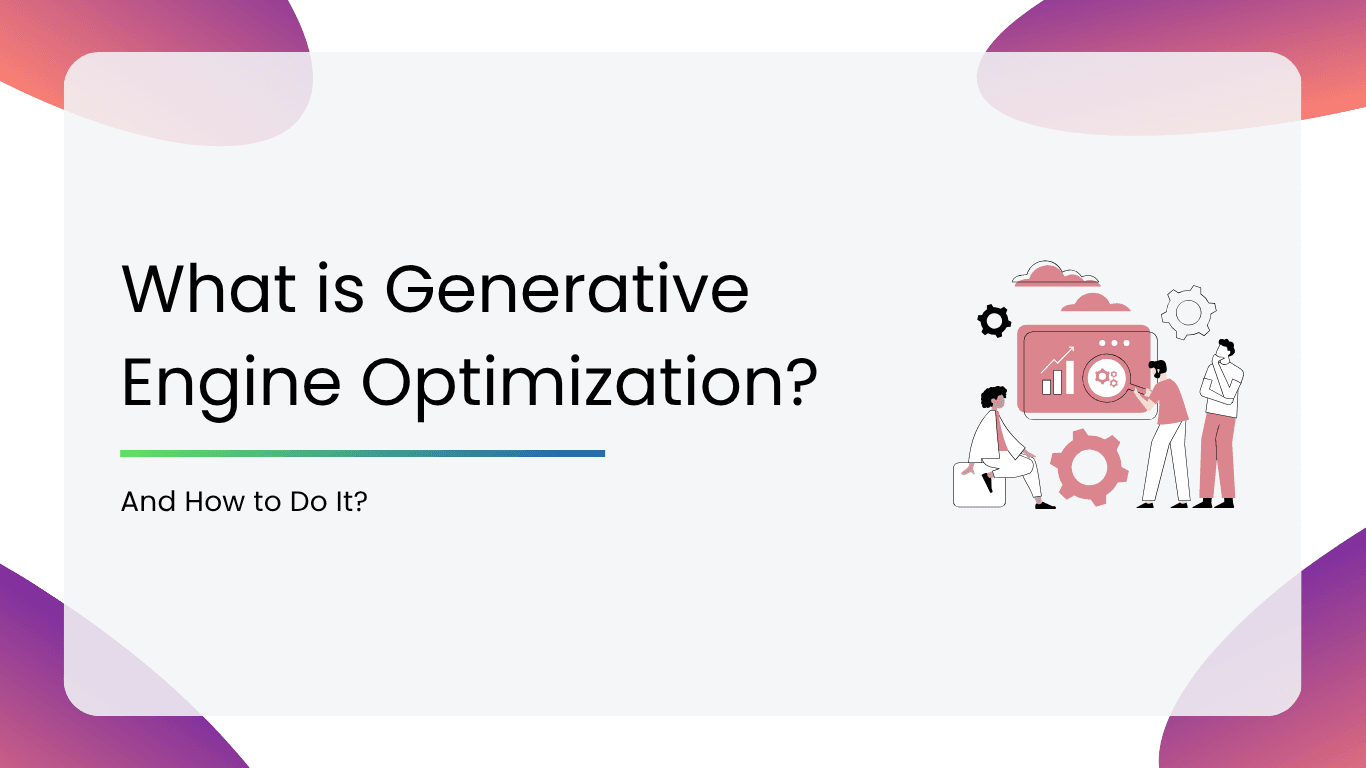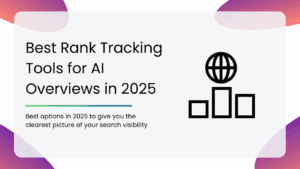Generative AI is changing the internet. It is changing the way people search and interact with content online. From AI-written blogs to auto-generated product descriptions, content is being created at lightning speed. With so much content around, one big question looms large: How will anyone find your content?
That’s where Generative Engine Optimization (GEO) steps in.
Just as Search Engine Optimization (SEO) was all about ranking higher on Google, the go-to search engine, Generative Engine Optimization (GEO) is about making your content discoverable by AI tools, the current and rapidly evolving search behavior. If you’re trying to stay relevant in a world of AI-powered search, understanding GEO is quickly becoming a must-have skill.
So, let’s understand what exactly is GEO, and how you can make your content more generative-engine-friendly?
What is Generative Engine Optimization (GEO)?
Generative Engine Optimization (GEO) is the practice of making your content easier to find, understand, and surface within generative AI tools, like ChatGPT, Google Gemini, Perplexity, and others.
Instead of ranking on a search engine results page like traditional SEO, your goal with GEO is to make sure your content is the source that AI models pull from when answering queries.
Imagine someone asks ChatGPT, “What are the best skincare brands for sensitive skin?”
If your blog, product page, or guide is optimized to GEO, there’s a higher chance the AI will reference your brand, link to your site, or even quote your content directly in the response.
GEO puts your content in front of users, without needing them to scroll through a long list of traditional blue links.
GEO vs SEO
At first glance, GEO might sound a lot like SEO, and that’s because the two share some common methodologies and goals. Both are about making your content more discoverable, more useful, and more aligned with what people are searching for.
But here’s the twist: GEO is built for AI, not just search engines.
Let’s break it down:
How GEO is similar to SEO?
You’ll recognize a few familiar points:
1. Visibility Matters: Just like Google, you want your content to show up when users ask AI tools questions.
2. Keyword Strategy Still Counts: Using the right language and phrases helps AI understand what your content is about.
3. User Experience is Key: Clear layout, scannable content, and helpful formatting all make a difference.
4. Content quality Wins: Whether it’s SEO or GEO, great content still makes the most impact.
5. Technical Optimization Helps: Fast-loading pages, mobile responsiveness, and structured data aren’t going anywhere.
6. Analytics Matter: Measuring what’s working and what’s not is just as important in the world of GEO.
So far, so familiar, right?
How is GEO different from SEO?
Here’s where things get AI-powered:
1. AI-First Platforms: SEO is about ranking on search engines like Google and Microsoft Bing. GEO is about showing up inside generative engines like ChatGPT, Gemini, or Claude.
2. It’s All About Context: AI tools focus on semantic relevance. They look at how well your content answers the intent behind a question, and not just whether it includes the keywords.
3. Formatting Matters: Clear headers, concise summaries, FAQs, and well-structured paragraphs make it easier for AI to pull and present your content.
4. Performance Metrics Shift: Traditional SEO focuses on clicks and bounce rates. GEO is about inclusion and citations. Are AI tools referencing your content in their responses? If so, what structures are they prioritizing?
5. AI Prioritizes Clarity: If your content sounds vague, lacks structure, or has no deep research, generative engines will likely skip it.
In short, GEO and SEO are part of the same family, but they’re playing in different arenas.
GEO vs SEO At A Glance
| Aspect | SEO (Search Engine Optimization) | GEO (Generative Engine Optimization) |
| Goal | Rank higher on search engine results pages (SERPs) | Be cited or referenced by generative AI tools |
| Platform Focus | Google, Bing, Yahoo | ChatGPT, Gemini, Perplexity, Claude. AI search agents |
| Keyword Use | Keyword density, exact-match phrases | Semantic relevance, context-rich phrasing |
| Content Structure | Optimized for crawlers and search snippets | Optimized for AI interpretation and summarization |
| User Journey | Encourages clicks to your website | Aims to deliver value within AI responses |
| Performance Metrics | Rankings, click-through rate, and bounce rate | Mentions, citations, source inclusion in AI outputs, and referral traffic |
| Best Content Formats | Blog posts, landing pages, pillar content | FAQs, summaries, structured guides, and clearly segmented content |
| Tools Involved | Google Search Console, Ahrefs, SEMrush | Clarity, schema, crawlability for AI, natural language structure |
| Technical SEO | Meta tags, XML sitemaps, site speed, mobile optimization | Clarity, schema, crawlability for AI, natural language structure |
| Main Challenge | Beating the algorithm to get visibility and clicks | Being understood and used by AI tools |
Why GEO is Important
How people search for information is changing fast. Not long ago, the default was Google. You’d type in a keyword, scroll through a list of blue links, and hope for the best. But now? More and more users are skipping the search engine altogether and heading straight to AI tools like ChatGPT, Perplexity, Claude, and Gemini to get their answers.
Gartner, the global research and advisory firm focusing on business and technology topics, predicts that by 2026, traditional search engine volume will drop by 25% as users move toward conversational AI and virtual assistants. There’s a huge shift in behavior, and one that content creators, marketers, and brands cannot afford to ignore.
Here’s what’s really happening:
- AI is becoming the new front door to information. People ask questions, get recommendations, and even make purchase decisions, all within generative tools.
- Consumer trust is shifting from websites and blogs to summarized AI responses. If your brand or content isn’t showing up in those answers, you’re invisible to a growing portion of your audience.
- New platforms are on the rise. Tools like Perplexity.ai and ChatGPT’s web browsing features are already competing with traditional search, and in some cases, outperforming it for quick, clear answers.
That’s why Generative Engine Optimization (GEO) matters. It’s not just another marketing trend, it’s the strategy that will keep your content visible, relevant, and competitive in the age of AI-powered search.
The Benefits of GEO
When done right, Generative Engine Optimization can supercharge your content strategy in ways that traditional SEO simply can’t. Let’s take a look at the biggest wins:
1. Expanded Reach
GEO puts your content directly into AI conversations. Instead of waiting for users to click your link on Page 2 of Google, your content can become part of the actual answer that AI tools deliver.
2. Better User Experience
Generative engines value clarity, structure, and helpfulness, which means when you optimize for GEO, you’re naturally creating easier-to-read, user-focused content.
3. Competitive Advantage
While most marketers are still figuring out SEO updates, GEO is your chance to leap ahead of the curve. If you’re early to optimize for AI, you’ll show up where others don’t.
4. Boost in Brand Authority
When AI tools repeatedly cite your content in their answers, users start to see you as a trusted source. That kind of third-party credibility is hard to buy, but easy to earn with a solid GEO strategy.
5. Deeper Insights
Optimizing for AI means you’ll start thinking more deeply about user intent, natural language, and contextual relevance. That leads to smarter content, better strategy, and more focused messaging overall.
6. Future-Proofing Your SEO
GEO helps you adapt to the revolving algorithm. By learning to optimize for generative engines now, you’re laying the groundwork for long-term visibility.
How GEO Works: The 8 Key Pillars
So you’re sold on the why. Let’s get into the how.
Here are the eight pillars that make GEO work:
1. Generative AI Research & Analysis
Before you start writing, you’ve got to understand how generative engines think.
- What kind of language do users use when asking AI questions?
- Look at AI Overviews in search results
- Analyze how your brand and competitors are being referenced in AI-generated answers
2. Content Quality & Relevance
High-quality content is still king, but in SEO, it needs to match intent perfectly.
- Align with user intent and context, not just keywords
- Keep your content fresh, authoritative, and easy to understand
- Use entities and structured language that AI tools can parse and contextualize
3. Content Structure & Clarity
If your content is hard to follow, AI will likely skip it.
- Use clear headings & subheadings
- Add bullet points and numbered lists for skimmability
- Offer direct, concise answers
- Include structured data and schema markup wherever possible
4. Content Distribution & Engagement
AI models crawl the web. Make sure your content is where people talk.
- Post on Reddit, Quora, and relevant forums
- Encourage user-generated content (UGC) and reviews
- Build social signals through consistent sharing and community engagement
5. Brand Authority & Credibility
Would you trust you? AI tools ask the same thing.
- Stay consistent in your brand voice and messaging
- Build ethical backlinks from high-authority sources
- Strengthen your offline reputation (mentions, events, PR) to reinforce online presence
6. Technical SEO
Under the hood? Yup, still crucial.
- Optimize for mobile and page speed
- Use structured tags, HTTPS, and ensure clean indexing
- Fix crawl issues and maintain technical health regularly
7. Experiment & Iterate
What works today might not work tomorrow. GEO offers a test-and-learn space.
- Try new formats, FAQs, carousels, and interactive tools
- Use A/B testing to compare clarity and engagement
- Track performance inside and outside of generative engines
- Keep an eye on emerging AI trends and technologies
8. GEO is Ongoing
There’s no “set it and forget it” here:
- Keep listening to user feedback
- Watch how AI responses evolve
- Stay plugged into algorithm updates
- Tweak, improve, repeat
Generative Engine Optimization isn’t a trend. It’s the next evolution of digital visibility. Whether you’re a solo content creator, a growing brand, or a marketer trying to stay ahead of the curve, GEO helps you show up where it counts: inside AI-powered answers.
You don’t need to become an AI engineer to make your content work for generative engines. You just need to understand how these tools read, rank, and respond, and start building smarter.
We’ve been exploring the exciting world of AI and how it’s reshaping content, strategy, and digital visibility. Check out some of our other must-read guides from the Smacient blog:
- Best AI SEO Tools & How to Use Them
- How to Check Website Traffic: Best Web Traffic Analytics Tools
- AI A/B Testing: How You Can Optimise Using AI
- Generative AI for SEO
FAQs
GEO success isn’t always measured in clicks; it’s about visibility within AI responses. You can test prompts manually in tools like ChatGPT, Perplexity, or Gemini to see if your content is being referenced.
Yes. For instance, some SaaS companies have structured their support articles and knowledge bases in ways that frequently show up in ChatGPT responses. Brands focused on structured data, clear FAQs, and consistent publishing have seen better placement in AI-generated answers.
A good GEO snippet is clear, concise, and structured. Think:
– A direct definition: “Generative Engine Optimization (GEO) is the process of optimizing content to be cited or referenced in AI-generated responses.”
– Followed by a short bulleted list, FAQ, or how-to. It mirrors how AI tools like ChatGPT or Perplexity present information: well-labeled, well-organized, and easy to summarize.
It depends on the topic. For all-time content, review and refresh every 3-6 months. For fast-moving spaces like AI or marketing trends, monthly updates may help you stay ahead. AI tools value fresh, relevant, and accurate content.
No, but it is evolving alongside it. While SEO helps you rank on traditional search engines, GEO ensures your content appears in AI-powered conversations. The best strategy is to do both.
Open tools like ChatGPT, Perplexity, etc., and ask the kinds of questions your audience would. See which sites or sources get referenced. If yours doesn’t appear, it’s time to tweak your structure, clarity, and relevance.





